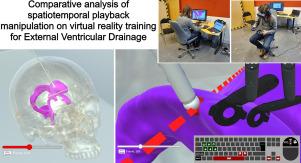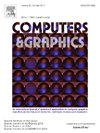时空回放操作对虚拟现实脑室外引流训练的比较分析
IF 2.5
4区 计算机科学
Q2 COMPUTER SCIENCE, SOFTWARE ENGINEERING
引用次数: 0
摘要
虚拟现实(VR)已在脊柱神经外科等多个外科专业得到广泛应用。然而,颅脑神经外科在这方面的研究相对较少。这项工作探讨了采用 VR 研究脑室外引流 (EVD) 的影响。在这项研究中,预先录制的 EVD 手术运动捕捉数据在 VR 头显上可视化,并与桌面显示器条件进行比较。参与者(20 人)的任务是识别并标记记录中的关键时刻。实验记录了客观和主观指标,如完成时间、时空误差距离、工作量和可用性。实验结果表明,与台式机相比,在 VR 中完成任务的平均速度是台式机的两倍。不过,台式机显示的易出错结果更少。主观反馈显示,在保持工作量相当的情况下,VR 环境在可用性方面略胜一筹。总之,VR 显示器有望成为颅脑手术教育和培训的替代工具。本文章由计算机程序翻译,如有差异,请以英文原文为准。

Comparative analysis of spatiotemporal playback manipulation on virtual reality training for External Ventricular Drainage
Extensive research has been conducted in multiple surgical specialities where Virtual Reality (VR) has been utilised, such as spinal neurosurgery. However, cranial neurosurgery remains relatively unexplored in this regard. This work explores the impact of adopting VR to study External Ventricular Drainage (EVD). In this study, pre-recorded Motion Captured data of an EVD procedure is visualised on a VR headset, in comparison to a desktop monitor condition. Participants () were tasked with identifying and marking a key moment in the recordings. Objective and subjective metrics were recorded, such as completion time, temporal and spatial error distances, workload, and usability. The results from the experiment showed that the task was completed on average twice as fast in VR, when compared to desktop. However, desktop showed fewer error-prone results. Subjective feedback showed a slightly higher preference towards the VR environment concerning usability, while maintaining a comparable workload. Overall, VR displays are promising as an alternative tool to be used for educational and training purposes in cranial surgery.
求助全文
通过发布文献求助,成功后即可免费获取论文全文。
去求助
来源期刊

Computers & Graphics-Uk
工程技术-计算机:软件工程
CiteScore
5.30
自引率
12.00%
发文量
173
审稿时长
38 days
期刊介绍:
Computers & Graphics is dedicated to disseminate information on research and applications of computer graphics (CG) techniques. The journal encourages articles on:
1. Research and applications of interactive computer graphics. We are particularly interested in novel interaction techniques and applications of CG to problem domains.
2. State-of-the-art papers on late-breaking, cutting-edge research on CG.
3. Information on innovative uses of graphics principles and technologies.
4. Tutorial papers on both teaching CG principles and innovative uses of CG in education.
 求助内容:
求助内容: 应助结果提醒方式:
应助结果提醒方式:


